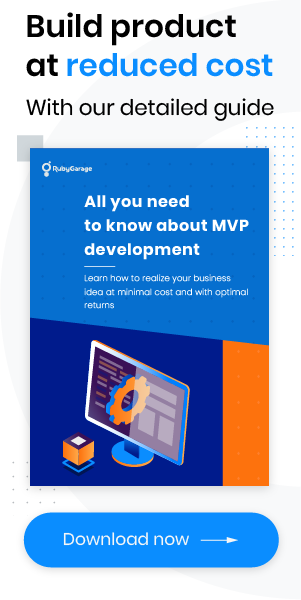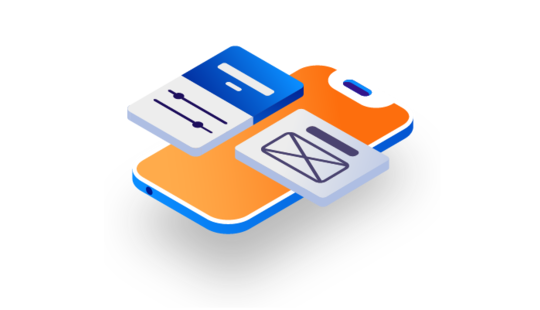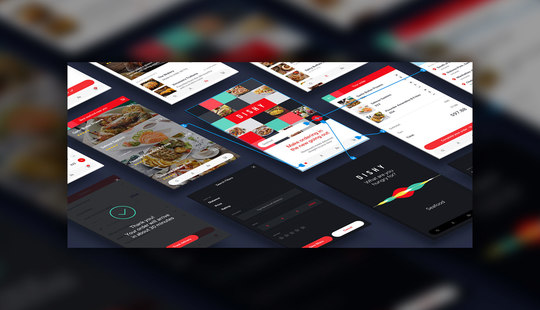-
Product Management
Software Testing
Technology Consulting
-
Multi-Vendor Marketplace
Online StoreCreate an online store with unique design and features at minimal cost using our MarketAge solutionCustom MarketplaceGet a unique, scalable, and cost-effective online marketplace with minimum time to marketTelemedicine SoftwareGet a cost-efficient, HIPAA-compliant telemedicine solution tailored to your facility's requirementsChat AppGet a customizable chat solution to connect users across multiple apps and platformsCustom Booking SystemImprove your business operations and expand to new markets with our appointment booking solutionVideo ConferencingAdjust our video conferencing solution for your business needsFor EnterpriseScale, automate, and improve business processes in your enterprise with our custom software solutionsFor StartupsTurn your startup ideas into viable, value-driven, and commercially successful software solutions -
-
- Case Studies
- Blog
6 Significant Reasons to Invest in UX Design
Building a digital presence ‒ on the web or within a mobile application ‒ is important for an organization of any kind. Companies rely on attractive interfaces, appealing content, and well-crafted marketing strategies to promote their web and mobile apps. In this bustle of building and promoting, however, people sometimes forget that fancy animations, unique content, and catchy ads should be backed by great UX (User Experience) design. In a nutshell, great UX design makes an app easy and pleasant to use and, as a result, increases customer satisfaction.
Despite the fact that the term “UX” has been around for a while, questions like “Why is user experience important?” and “Why is UX design important?” still pop up all the time during the app design process. In this article, we’d like to talk in detail about the benefits of investing in UX design for your project.
Reason #1: UX design cuts down development costs
What if we told you that proper UX design allows you to stay within budget or even cut costs of development? To understand how, we need to look closer at the various stages of UX design.
Good UX design is the result of comprehensive user research, information architecture design, wireframing, prototyping, user testing, and final implementation. UX designers spend hours redesigning and polishing an app to meet the needs of end users.
We won’t describe all the stages mentioned above in detail. Instead, we’ll focus on two major stages that influence the final cost of an application.
Prototyping
Prototypes are UX-stage deliverables that mock the final product ‒ as a rule, these prototypes are mid or high fidelity, mimicking the appearance of the final product but without all of the underlying functionality. A prototype isn’t a real product, though some people mistakenly believe they are. The purpose of a prototype is to validate your app idea by letting real users test it. As a rule, UX designers use prototypes to test usability (how easy an app’s interface is to use) and feasibility (what technology is required to power the UX design).
Prototyping impacts the overall development cost. Effective prototyping can keep costs down by helping you:
- Estimate more accurately. Making structural changes at the final design implementation stage is time-consuming and costly. The design of an app’s information architecture and the positioning of blocks and determination of their sizes should be done at the prototyping stage so that developers can accurately estimate the time and efforts required for implementation. Effective prototyping helps you get more precise figures instead of rough estimates.
- Avoid feature creep. Feature creep is characterized by the adding of more and more unnecessary features that result in failed deadlines and blown budgets. Feature creep can be prevented with the help of prototyping. Instead of relying on you inner sense (“I believe this feature is vitally important”), you use prototypes to see how real users react to your product and make an unbiased decision.
- Test out your application’s content. Content is a king when it’s coupled with great design. According to Adobe’s research, 38% of people are likely to leave a website if either its content or layout looks unattractive. At the prototyping stage, you’re able to test how your content is received (texts, images, videos, etc). Testing your content can help you craft a content marketing strategy that goes well with your application’s design and pleases your customers with a unified aesthetic.
Usability Testing
Usability (or user) testing strives to simulate situations in which an end user will actually use your product. You might wonder: Why bother engaging outside people in testing if I have enough team members? Everyone involved in the processes of delivering an app, including designers and developers, spend a lot of time working closely with the application. This proximity leads to bias, and people close to a project can’t always see flaws that are evident from an outsider’s perspective. Usability testing attempts to get past this bias.
At the usability testing stage, users help UX designers make sure that the app is convenient and easy to use. We can check various elements during user testing: the size of buttons (are they easy to interact with?), fonts (are they readable?), the positioning of blocks, sequence of registration steps, buying funnel, and so on.
By performing usability testing, we avoid implementing inconvenient design, and therefore avoid reworking inconvenient design solutions later on.

Reason #2: UX design increases your revenue
Have you ever wondered why your prefer one website to another when they effectively deliver the same content, range of goods, and pricing? UX design proves that love at first sight really exists; a full 75% of people judge a website based on its overall aesthetics. A user-friendly interface that fulfills a customer’s needs is more likely to convert customers.
Numerous agencies study the impact of user experience on conversion rates. Let’s take a look at a few elements of successful UX design can help you increase your revenue.
- Ease of use. Ease of use directly impacts your sales. Indicators of an easy-to-use application include intuitive navigation, useful onboarding, and UX design patterns that require no time to learn. If your website conforms to generally accepted rules of usability, your visitors are more likely to perform the desired interactions ‒ for instance, make a purchase, subscribe, or create an account.
- Reduced number of steps. In a customer journey map (which we’ll talk about later), a user performs a certain number of interactions (“steps”) that help them achieve their goal (to book a flat or donate to charity, for example). The more steps it takes for users to achieve their goals, the less motivated they will be to fulfill them. Steps may include compulsory registration or filling in personal details in a form. To reduce the number of steps required, UX designers come up with solutions like one-page checkouts that allow customers to proceed to purchase right after they’ve picked the product.
- Clear calls to action (CTAs). A button that says “Subscribe to our email list” or “Contact us” is an example of a call to action. UX designers understand that leaving users without a clear call to action isn’t acceptable. In fact, KISSmetrics found that a video with a CTA button got 380 times more clicks than the same video without a CTA ‒ pretty convincing, isn’t it?
Surely, the approaches listed above aren’t the only ways to boost your conversion rates. In one of our previous articles, we listed 12 effective tips for ecommerce, including user experience benefits.
Before moving on, we would like to underscore that a successful UX strategy not only converts new visitors, but retains existing customers as well. The ROI of every dollar invested in UX design ranges from $10 to $100.

Reason #3: UX design motivates your users to interact with your content
Content is basically anything we see on a webpage or inside a mobile app. Content refers to texts, images, videos, advertisements, and so on. Whether you run a lifestyle blog or an ecommerce website, you deliver content of some kind. Today’s blogs are more often associated with images and videos than with textual blog posts ‒ in large part to target millennials. But no matter the format, content is created to be shared with masses of people.
What role does UX design play in motivating users to interact with your content ‒ to read an article on your blog, view related blogs posts, or purchase an item? There are many content design techniques to help you befriend users with your content. Let’s take a look at a few of them.
First of all, when designings app, UX designers meticulously create user personas, or descriptions of people who will potentially use an app. User personas look like profiles of real people, and include personal information, biographies, and motivations for using your app. User personas allow UX designers to get a better feel for their target audience and create user experiences that inspire end users to browse your website or mobile app.
Second, modern UX design focuses on personalization. Personalized user experiences are about delivering content that is relevant to a specific user. Blocks on ecommerce websites that say, “You’ll also like these products,” “Similar to the items you’ve recently viewed,” and “Inspired by your wishlist” effectively grab people’s attention. In fact, 56% of people reveal that they’re likely to return to a website that shows recommendations.
Finally, UX designers work to achieve consistency. Consistent design is predictable and comfortable. It is comprised of well-known elements like menus on the left side and breadcrumbs for easy navigation, so your users don’t have to take additional time to learn how to navigate through your app.
In other words, when a user visits an unfamiliar website that contains familiar UX elements, they immediately understand the purpose of the website and can smoothly navigate it.
We’ve mentioned just a few examples of how UX design can bridge the gap between your content and your users. There are many other fascinating examples of how websites and mobile apps help people gain loyal customers by putting content in the right place at the right time.

Reason #4: UX design increases customer loyalty
As we mentioned before, great UX design not only attracts new users, but also retains them. Returning users are loyal users. Customer loyalty is won through positive experiences with a web or mobile app. These positive experiences bind users to your product and keep them coming back for more.
One of the approaches to building customer loyalty is creating a customer journey map (CJM). UX designers create customer journey maps to represent the customer’s interaction with the product starting from the very first contact (the “contact point”). CJMs can be delivered as visual (diagrams) or textual (storytelling) documents ‒ there’s no right or wrong way to make a customer journey map. A CJM can help you increase the loyalty of your visitors by helping you:
- Build empathy. Empathy is understanding the needs of your target audience or, as a famous proverb says, “walking in your audience’s shoes.” A well-crafted CJM reveals the emotional state of your users at different stages of their journey (for example, after successfully finishing onboarding).
- Identify bottlenecks. When a user faces an issue while trying to perform an action (for example, the website doesn’t accept a credit card during checkout) or can’t find a necessary element (like a menu hidden behind a hamburger button), these interactions can turn them away from your website or app. A CJM can help you identify bottlenecks, or things that cause your users feel frustrated, and fix them.
- Increase retention rate. Retention rate is especially important for ecommerce. A CJM allows UX designers to track customers’ interactions with content, determine customer satisfaction ratings, gather usability scores, and collect other relevant data. Collectively, these metrics give UX designers the insights they need to optimize their designs in order to better engage visitors and win their loyalty.

Reason #5: UX design stimulates word-of-mouth
In the previous section, we talked about approaches to building a tight connection between your application and your users. In this section, we’ll talk about another powerful marketing tool that can be encouraged with proper UX design ‒ word-of-mouth.
More contact means more sharing of information, gossiping, exchanging, engaging – in short, more word-of-mouth.
Word-of-mouth is the sharing of information about a product or service through personal communications, on social media, and in day-to-day interactions. When people spread the word about your product just because they want to and not because you’ve paid them, then your product is being advertised by word-of-mouth.
It would take a separate article to talk about the importance of word-of-mouth promotion and ways to motivate people to talk about your product, but in this article we’ll briefly explain how UX stimulates word-of-mouth.
- Facilitates social sharing. UX designers realize the importance of social sharing. One example of this recognition is the displaying of links to social media sites targeted at specific audiences. For example, art websites like Dribbble offer easy sharing to other sites for creatives, such as Tumblr, Pinterest, Facebook, and Twitter instead of to more formal sites like LinkedIn. Social integrations allow you to better reach your target audience and offer a convincing value proposition.
- Promotes trust. People tend to believe others who are like them and tend to learn behaviors from their peers. UX solutions such as reviews, star ratings, and “people who bought this item also bought” features build customers’ sense of trust, encourage customers to talk about a product and, as a result, increase average order sizes.
Reason #6: UX design keeps you from wasting resources
By investing in better UX design solutions, you’re able to avoid wasting human resources, time, and money.
Your “human resources” are all the people involved in creating your product. Unfortunately, when employees aren’t managed well, the result can be financial losses. An example of such misuse of resources is hiring marketers and sales managers to promote a product without investing in a user experience that delights users.
Time is a valuable resource that directly impacts the financial side of a project. Previously, we mentioned that UX design helps avoid feature creep with the help of prototyping and user testing. In addition, user experience research helps you detect inefficient solutions and prevent their implementation at the development stage by tailoring your features to meet the needs of your target audience.

A great user experience won’t leave your visitors indifferent. Marketers and analysts can try their best to predict the behaviors of users, but in the end users are still largely led by emotions. While it’s not possible to predict what your users want with 100% certainty, designing a captivating UI and UX, though a difficult task, is worthwhile.















